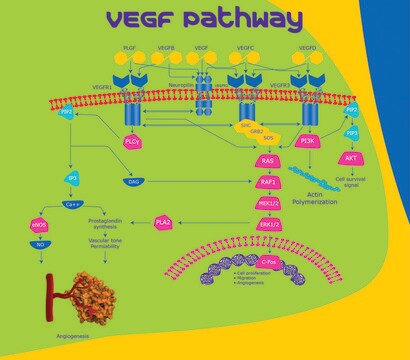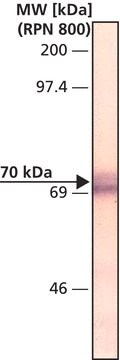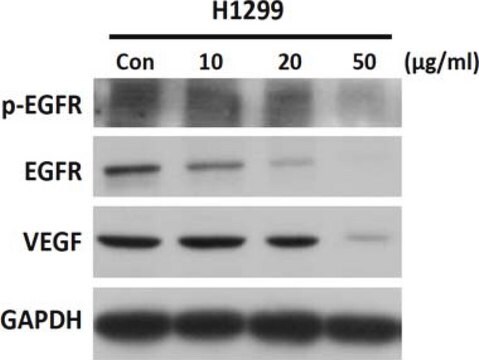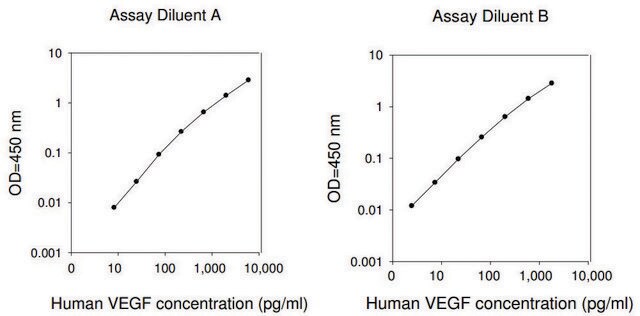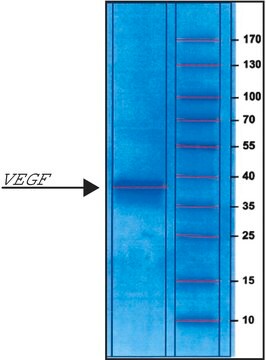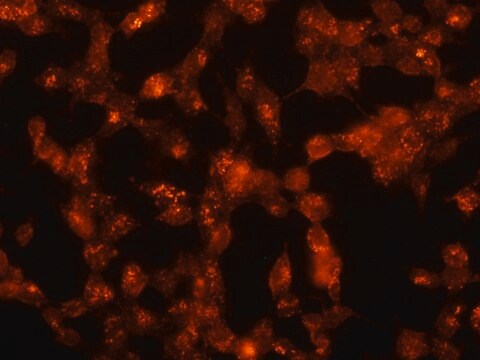V1385
VEGF Receptor-1 (Flt-1)/Fc Chimera human
>90% (SDS-PAGE), recombinant, expressed in baculovirus infected Sf21 cells, lyophilized powder
Synonym(s):
Vascular Endothelial Growth Factor Receptor‑1
Sign Into View Organizational & Contract Pricing
All Photos(1)
About This Item
Recommended Products
biological source
human
Quality Level
recombinant
expressed in baculovirus infected Sf21 cells
assay
>90% (SDS-PAGE)
form
lyophilized powder
potency
≤35 ng/mL ED50
mol wt
predicted mol wt ~100 kDa
packaging
pkg of 50 μg
storage condition
avoid repeated freeze/thaw cycles
impurities
endotoxin, tested
UniProt accession no.
storage temp.
−20°C
Gene Information
human ... FLT1(2321)
Application
VEGF Receptor-1 (Flt-1)/Fc chimera human may be used tostudy vasculogenesis and angiogenesis.
Biochem/physiol Actions
VEGF R1 binds VEGF with high affinity and is a potent VEGF inhibitor.
VEGF Receptor-1 (VEGF R1) also known as Flt-1 belongs to class III subfamily of RTKs and is a potent VEGF antagonist expressed mainly in endothelial cells. VEGF R1 binds to vascular endothelial growth factor B (VEGF-B) and regulates the activity of plasminogen activator in endothelial cells. It also assists endothelial cells in the proper spatial organization of lumen-containing vessels. Additionally, alternatively spliced VEGF R1 pre-mRNA helps in regulating the VEGF activity in angiogenesis. VEGF R1 also activates PLC gamma which in turn produces cellular signaling molecules diacylglycerol as well as inositol 1,4,5-trisphosphate and activates protein kinase C.
VEGF receptors, class III receptor tyrosine kinases, have seven Ig like extracellular motifs and a tyrosine kinase intracellular domain split by a kinase insert sequence. VEGFR 1 was originally called fms like tyrosine kinase 1 (flt 1), indicating its homology to receptors of PDGF, M CSF, and SCF. VEGFR 1 is one of the five receptor tyrosine kinases (KDR/Flk-1, Flt-4, tie-1 and tek/tie-2) whose expression is almost exclusively restricted to endothelial cells. These receptors are likely to play central roles in vasculogenesis and angiogenesis. Recombinant VEGF R1 binds VEGF with high affinity and is a potent VEGF inhibitor. VEGFR 1 and 2 are both expressed in an endothelial cell-specific manner and are detectable in virtually all tissues in adults and embryos. Hypoxia induces endothelial cell expression of VEGFR 1 but not VEGFR 2. Monocytes express VEGFR 1 and 2 and can migrate to the site of VEGF release, but this response appears to be VEGFR 1 mediated. VEGFR 2 is also expressed in pancreatic duct cells. VEGFR 2 is involved in commitment of endothelial-cell lineages and to cell proliferation, while VEGFR 1 seems to be responsible for guiding endothelial cells into the proper spatial organization into lumen-containing vessels. VEGFR 2 is a key marker for pluripotent HSCs. Neurophilins, a group of unrelated receptors for some VEGF family members may also act as coreceptors to facilitate VEGF binding to VEGFR 2. VEGFR 3 is a specific marker for lymphatic vessels. VEGFR 3 has also been detected on some high endothelial venules, in embryonic pre-lymphatic blood vessels, some tumor blood vessels, and certain hematopoietic and leukemia cells.
Physical form
Lyophilized from a 0.2 μm filtered solution in 20 mM MOPS, 500 mM sodium chloride, 0.05% CHAPS, pH 7.0 containing 50 μg bovine serum albumin per 1 μg of cytokine
Analysis Note
The biological activity is measured by its ability to Inhibit the VEGF-dependent proliferation of human umbilical vein endothelial cells.
Storage Class
13 - Non Combustible Solids
wgk_germany
WGK 3
flash_point_f
Not applicable
flash_point_c
Not applicable
ppe
Eyeshields, Gloves, type N95 (US)
Choose from one of the most recent versions:
Already Own This Product?
Find documentation for the products that you have recently purchased in the Document Library.
A Sawano et al.
Biochemical and biophysical research communications, 238(2), 487-491 (1997-09-23)
Flt-1, a tyrosine kinase receptor for vascular endothelial growth factor (VEGF), plays important roles in the angiogenesis required for embryogenesis and in monocyte/macrophage migration. However, the signal transduction of Flt-1 is poorly understood due to its very weak tyrosine kinase
Y He et al.
Molecular endocrinology (Baltimore, Md.), 13(4), 537-545 (1999-04-09)
Angiogenesis is essential for normal mammalian development and is controlled by the local balance of pro- and antiangiogenic factors. Here we describe a novel mouse cDNA sequence encoding sFLT-1 that is a potent antagonist to vascular endothelial growth factor (VEGF)
B Olofsson et al.
Proceedings of the National Academy of Sciences of the United States of America, 95(20), 11709-11714 (1998-09-30)
The vascular endothelial growth factor (VEGF) family has recently expanded by the identification and cloning of three additional members, namely VEGF-B, VEGF-C, and VEGF-D. In this study we demonstrate that VEGF-B binds selectively to VEGF receptor-1/Flt-1. This binding can be
Our team of scientists has experience in all areas of research including Life Science, Material Science, Chemical Synthesis, Chromatography, Analytical and many others.
Contact Technical Service